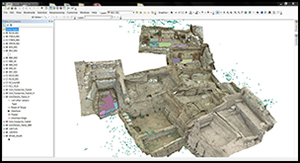Crossref Citations
This article has been cited by the following publications. This list is generated based on data provided by
Crossref.
Smith, Neil G.
Howland, Matthew
and
Levy, Thomas E.
2015.
Digital archaeology field recording in the 4th dimension: ArchField C++ a 4D GIS for digital field work.
p.
251.
Ćwiąkała, Paweł
Matwij, Karolina
Matwij, Wojciech
Miszk, Łukasz
and
Winiarska, Weronika
2015.
Integration of 2D and TLS Data Using GIS to Create a Database for the Paphos Agora Project.
Studies in Ancient Art and Civilisation,
Vol. 19,
Issue. ,
p.
203.
Morgan, Colleen
2016.
Analog to Digital: Transitions in Theory and Practice in Archaeological Photography at Çatalhöyük.
Internet Archaeology,
Lercari, Nicola
2016.
Digital Methods and Remote Sensing in Archaeology.
p.
3.
Alcock, Susan E
Dufton, J Andrew
and
Durusu-Tanrıöver, Müge
2016.
Archaeology and the MOOC: Massive, open, online, and opportunistic.
Journal of Social Archaeology,
Vol. 16,
Issue. 1,
p.
3.
Lercari, Nicola
2016.
Handbook on 3D3C Platforms.
p.
337.
Dallas, Costis
2016.
Digital curation beyond the “wild frontier”: a pragmatic approach.
Archival Science,
Vol. 16,
Issue. 4,
p.
421.
Dell’Unto, Nicoló
2016.
Digital Methods and Remote Sensing in Archaeology.
p.
305.
Mickel, Allison
2016.
Tracing Teams, Texts, and Topics: Applying Social Network Analysis to Understand Archaeological Knowledge Production at Çatalhöyük.
Journal of Archaeological Method and Theory,
Vol. 23,
Issue. 4,
p.
1095.
Olivito, Riccardo
Taccola, Emanuele
and
Albertini, Niccolò
2016.
Digital Methods and Remote Sensing in Archaeology.
p.
475.
E. Jackson, Sarah
F. Motz, Christopher
and
A. Brown, Linda
2016.
Pushing the Paperless Envelope.
Advances in Archaeological Practice,
Vol. 4,
Issue. 2,
p.
176.
De Roo, Berdien
Stal, Cornelis
Lonneville, Britt
De Wulf, Alain
Bourgeois, Jean
and
De Maeyer, Philippe
2016.
Spatiotemporal data as the foundation of an archaeological stratigraphy extraction and management system.
Journal of Cultural Heritage,
Vol. 19,
Issue. ,
p.
522.
Hernandez, David Ray
2017.
Wet-Site Excavation and Field Methodology at Butrint, Albania: The Roman Forum Excavations Project.
Journal of Field Archaeology,
Vol. 42,
Issue. 4,
p.
312.
Scarre, Chris
2017.
EDITORIAL.
Antiquity,
Vol. 91,
Issue. 360,
p.
1413.
Lercari, N.
2017.
3D visualization and reflexive archaeology: A virtual reconstruction of Çatalhöyük history houses.
Digital Applications in Archaeology and Cultural Heritage,
Vol. 6,
Issue. ,
p.
10.
Shillito, Lisa-Marie
2017.
Multivocality and multiproxy approaches to the use of space: lessons from 25 years of research at Çatalhöyük.
World Archaeology,
Vol. 49,
Issue. 2,
p.
237.
Ulguim, Priscilla F.
2017.
Human Remains: Another Dimension.
p.
71.
Dell'Unto, Nicoló
Landeschi, Giacomo
Apel, Jan
and
Poggi, Giulio
2017.
4D recording at the trowel's edge: Using three-dimensional simulation platforms to support field interpretation.
Journal of Archaeological Science: Reports,
Vol. 12,
Issue. ,
p.
632.
Der, Lindsay
and
Issavi, Justine
2017.
The Urban Quandary and the ‘Mega-Site’ from the Çatalhöyük Perspective.
Journal of World Prehistory,
Vol. 30,
Issue. 3,
p.
189.
Emmitt, Joshua
Sefton, Briar
Phillipps, Rebecca
Wendrich, Willeke
and
Holdaway, Simon
2017.
Reimag(in)ing the Past.
Advances in Archaeological Practice,
Vol. 5,
Issue. 1,
p.
44.





